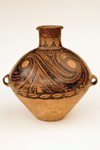 India,
China, Gansu or Qinghai Province India,
China, Gansu or Qinghai Province
Neolithic period, Gansu Yangshao culture, Banshan type, about 3rd-2nd millennium B.C.E.
Earthenware painted with red and black slips
H. 15 5/8 in. (39.7 cm), D. 13 3/4 in. (34.9 cm) without handles; 1979.125
|
|
Milton Glaser
When we see objects of such primal power and expressiveness, we are forced
to question any notion that art improves in quality as we progress historically.
Quite the contrary, this dynamic prehistoric storage jar puts most of the
ceramics created in our time to shame. The painting of the swirling forms
at the top of the jar are executed with a virtuosos skill and daring. Although
there is a functional reason for the bottom of the vessel to be left unpainted,
the compression and activity at the top is enhanced by the contrast of the
unadorned base. In a time of technological obsession, this piece reminds
us of the fact that astonishing objects can be created out of the most fundamental
means. Clay, water, fire, and the human imagination.
Xu Bing
In
the past, there were many ceramic jars of this type buried in the loess
of northern Shaanxi. Most of them had been used for funerary purposes. Therefore,
there was a custom among the local farmers to smash the jars immediately
upon discovering them. If they did not, it was considered unlucky. It was
only when outsiders began to come to look for the jars that the local people
started valuing them. However, most of the jars in the fields had been discovered
by that time. Oh well, museums are already full of them anyway.
|
 India,
China, Gansu or Qinghai Province
India,
China, Gansu or Qinghai Province